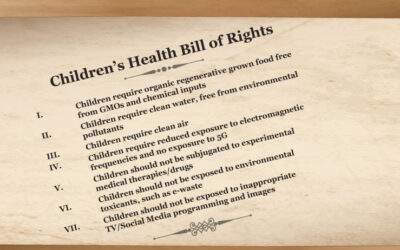The California-based pediatrician Michelle Perro, MD has spent the past 20 years of her 37-year career treating children with complex health problems – and has earned a reputation for some remarkable successes. Together with medical anthropologist Vincanne Adams, PhD, she has written a book, What’s Making Our Children Sick? How Industrial Food Is Causing an Epidemic of Chronic Illness, and What Parents (and Doctors) Can Do About It. The book identifies industrially produced food – including genetically modified (GM) foods and their associated pesticides – as a major culprit in the current health crisis. It also recommends measures we can all take to restore our health and well-being. Dr. Perro is also the Executive Director of GMOScience.org.
GMOScience interviewed Dr. Perro about the new book and the discoveries she has made in her medical practice. An interview with Professor Adams will follow shortly.
Q: Why did you write this book?
I’ve always considered myself a ‘front-line’ doctor, whether attending in the Emergency Department or working in the clinic, with my focus on taking care of patients. Over the past two decades I’ve moved from the arena of acute care medicine into integrative medicine, with a personal story creating the impetus for the change. Many practitioners discover integrative care when their own children or they themselves fall out of the purview of conventional medicine. In my case, it was my son who fell ill. But more generally, over the past two decades I’ve observed a rapid decline in children’s health. Coupled with my becoming involved with work against spraying pesticides in California in 2006 and receiving a crash course introduction to genetically modified (GM) foods at that time, I recognized that what I was seeing in my patients correlated with the parallel introduction of GM food and increased pesticide usage in our food supply. Our children had become a science experiment and the results were not looking favorable for them.
I began working in an integrative clinic five years ago, caring for some of the most chronic, complex health challenges in children that I could ever imagine. The crux of the practice of holistic care is that it is individualized, and that requires taking a significant amount of time sorting out each patient’s history and working out a unique treatment plan. One day at the end of a busy clinic session, I came to the realization that there were a finite number of children that I could see in a day. And I became concerned regarding the multitude of children that I could not see, that didn’t have access to the type of practitioner that looked at toxic food and environmental poisons as being potential culprits in the decline of kids’ health. Nor did parents have the information on how to get the help their children needed. So I decided to write a book. I had a serendipitous encounter with Dr. Vincanne Adams, an extraordinary, brilliant medical anthropologist and author and together, we married the fields of clinical medicine and anthropology to create our book, What’s Making our Children Sick?
Clinicians look for patterns and I’ve seen so many children now with gut dysfunction that I can sort out the issues quickly. The most common disorders I see are related to gut function, specifically food allergies (along with other allergy-related diseases such as eczema and asthma), gastroesophageal reflux, chronic abdominal pain, constipation, and brain issues such as autism spectrum disorder, attention deficit hyperactivity disorder (ADHD), learning challenges, behavioral and mood problems, and sleep disorders.
What people don’t often know is that the gut and brain health are inexorably linked. Unhappy gut, unhappy brain. Looking at some of the laboratory test results, common findings are food antibodies, including the life-threatening type (IgE antibodies), as well as IgG and IgA antibodies (which are often reported as ‘food intolerances’ but are indeed an immune reaction), low levels of digestive enzymes, and abnormal stool results. We also commonly find altered nutrient levels, heavy metal exposures, and chronic infections – but let’s stay focused on the gut.
We pediatricians deal with poop and pee most of our day. The majority of kids I see have abnormal findings in the poop. Often they have a low array of microbial diversity, early markers of inflammation (which can be a precursor to later autoimmune dysfunction), inadequate breakdown of fat and protein, and low levels of the important beneficial bacteria.
The bacterial composition of our gut (also known as the microbiome) is presently being actively researched and is at the forefront of medicine. It’s important for many of our body’s functions, including detoxification, production of vitamins and neurotransmitters, and helping the immune system work at its best (see our book for more information).
The key take-home point is that when patients change their diets to organic food, they get better. I’ve been asked by interviewers in the past to give examples of patients who got better by just switching to an organic diet and I’ve been unable to do that since I treat with many simultaneous therapies and often don’t know which one worked. (Remember, I’m not conducting a science experiment, but treating a patient!) My patients are also receiving herbs, supplements, and homeopathic remedies that I recommend, but what is remarkable is that family members who are not my patients also get significantly better, which I will discuss in the next section.
Q: Are there any stand-out cases that were especially important or educational for you?
One of my cases involved a severely autistic five-year old boy and his parents, from the Central Valley of California, a food-growing region that is heavily sprayed with pesticides. The dad had only 20% of his kidney function remaining, which is a very ominous situation that often leads to the need for dialysis. Several family members who are also neighbors residing in the same area were already receiving dialysis. The dad’s nephrologist (kidney doctor) thought it was some ‘genetic’ disease. I treated the child with supplements, herbs, and homeopathic remedies and he got markedly better over two years. However, the cornerstone of treatment was that the entire family switched to organic food. This was difficult for them because they lived in a heavily-sprayed area and shopped mostly in stores that didn’t stock organic food. Switching to organic food was also a stretch on their budget, but they stopped eating out and dad took his home-cooked, organic meals to work. The dad also decreased his intake of takeout and processed foods, but the majority of his dietary change was switching to an organic diet.
Over the next eight months, the dad’s kidney function returned to 80% normal. He was not my patient, in the sense that no other treatment was offered to him other than changing to an organic diet (which by definition is non-GMO).
When he went for his follow-up appointment with his nephrologist, she was shocked by the return to near-normal kidney function. When he explained how he did it, she stated that it was “impossible”. I was so profoundly affected by this patient and his family, as well as his physician’s response, that I felt compelled to tell their story in our book. I carry this story with me to share with others and show them that even the most serious illnesses can be reversed. It gives people hope.
Q: You’ve read a lot of research studies on the health effects of GMOs and pesticides. What links do you see, if any, between what’s occurring in your patients and what’s evident in the studies?
I’ve felt frustration over the past two decades over the lack of research on the effects of GM foods and their associated pesticides on human health. I’ve had to extrapolate data from rats, chickens and pigs to treat patients!
But several animal studies caused light bulbs to switch on in my head. The first was in 1999, when I viewed the histopathology slides of the work of Dr. Arpad Pusztai, a European scientist. His research examined rats fed GM potatoes compared to those fed non-GM potatoes.[1] (For more information on these studies, please see the book, GMO Myths and Truths, which holds a prominent place on my bookshelf.) When I saw the intestinal disruption of the villi in the rats (fingerlike projections in the gut lining responsible for nutrient absorption), it brought to mind the explosion of intestinal permeability that I was seeing in my child patients. This is not to say that we can extrapolate the findings of one study on one GM food to all GM foods: each GM crop is different and needs to be studied separately. But Pusztai’s study helped me get started on the scientific journey of learning more about the effects of these new foods on health.
The second ‘aha’ moment was viewing the gross pathology found in the study on pigs carried out by Dr. Judy Carman and Howard Vlieger.[2] The stomachs of pigs fed GM soy and corn, their typical diet, were compared to those fed non-GM soy and corn. The visual difference of the extensive inflammation in the GM-fed pigs compared to the normal stomachs of the non-GM fed pigs was shocking and supported my suspicion that many of the gut disorders I refer to above were being caused by GM foods and/or their associated pesticides.
I’ve questioned over the years whether the problems suffered by my patients are caused by the genetic modification process, the pesticides that the GM crops express or are grown with, or a combination of these factors. One of very few studies to address this question – Arpad Pusztai’s study on GM potatoes – found that the GM potatoes were unexpectedly toxic, but the non-GM potatoes spiked with the insecticide that the GM potatoes were engineered to express were not. This shows that something about the GM process made the potatoes toxic and that with this particular GM food, the problem was not with the insecticide engineered into them.
However, detailed testing of this type, which can identify which of several different components of a GM food is responsible for a certain effect, is not generally done with GM crops before they are commercialized. So we are still very much in the dark regarding the precise cause of those effects from a GM diet that have been found in animal studies.
Two further independent studies that helped improve and alter my practice were based on work led by Prof Gilles-Eric Seralini and some followup research led by Dr. Michael Antoniou, on rats fed GM corn. Prof Seralini’s team concluded that there were toxic effects to the liver and kidney of rats fed GM corn and an ultra-low dose of the glyphosate-based herbicide (Roundup) that it was engineered to be grown with, when tested separately and together.[3] So this research suggests that toxic effects were caused by both the genetic modification process and the Roundup herbicide.
Recent followup studies led by Dr. Antoniou used cutting-edge “molecular profiling” (transcriptomics, proteomics, and metabolomics) analytical techniques to examine tissues taken from the rats in the Séralini experiment.[4],[5] These studies showed that an ultra-low dose of Roundup fed over a long-term two-year period caused kidney and especially liver damage, resulting in Non-Alcoholic Fatty Liver Disease (NAFLD). NAFLD now affects 1 in 4 American adults and is also becoming a problem for children.
Q: What shocked or surprised you most in your ‘journey of discovery’ on these topics?
I was shocked first by the fact that these findings were unreported and unknown among health practitioners. Second, I was shocked by the vehemence of the attacks on scientists whose work questions the safety or efficacy of GM foods and their associated pesticides (some of the scientists who led the studies I mention above are cases in point). Such attacks are not only ethically wrong, but discourage others from questioning the effects of industrial food on health. Third, I was shocked that many of these findings were known to the regulatory agencies that were designed to protect the public from the untoward effects of new products on health. But these agencies succumbed to the pressure by big agribusiness and failed to do their job. And last but not least, I was shocked to find that there are no human studies on the effects of GM food on health. Additionally, there are no human studies on the health effects of combinations of toxins. Understand that if there is a leaky gut, not only do foods cross before they are completely broken down, but other microbial toxins and environmental toxicants can also cross into the bloodstream. The effect of this chemical and GMO soup on health has not been addressed.
Q: What are your recommendations for anyone who thinks that something in their diet might be causing or exacerbating their health problems?
The global advice I give to my patients is to try to eat an organic diet based on whole foods, avoiding processed food as much as possible, with the realization that on some days there will be suboptimal eating. We don’t strive for perfection, but to do the best we can. Then they can see the health benefits for themselves, from within a few days to a few weeks. It’s helpful if they can find an integrative practitioner or holistic nutritionist to advise them on how to eat, taking into account our modern food supply.
Families often raise the issue of cost since organic food is more expensive than non-organic food. (Remember, food grown with agrochemicals in the US is subsidized; organic food is not.) However, once they make the switch and start cooking at home and eating out less, most families report that they are under budget.
What I do worry about when making these changes for families is giving moms more work. They are often the ones carrying the weight regarding their children’s care. I request that everyone get in the kitchen and prepare and cook the family meals. The literature shows that kids do better when eating meals together with parents, especially when they helped to make those meals.
Q: What would you say to people who say that GMOs and pesticide residues present in food have been shown to be safe and are approved by regulators, and that you are misleading the public and health practitioners?
I advise them to do their own research. Unfortunately, agribusiness runs several prominent websites that are slick, polished, and convincing. I give my families other sites to look at, as well as the actual research papers, for those that are so inclined. The intention of GMOScience is to offer digestible bites of information from unbiased sources on the effects of GM food and pesticides, with a specific focus on health. This stuff can be confusing! However, the proof of the pudding is in the eating. I ask families to try their own home experiment, change their diets and see how they feel!
Q: Is there anything else you wish to say?
My hope for this book is to reach those individuals who are concerned about the current epidemic of illness and want to help change this ominous course. I support readers to question our book and do their own investigations. I’m hopeful that parents will engage in meaningful dialogues with their own pediatricians and that together we can create positive change. I’m fully confident that we can restore our children and ourselves to our natural state of good health.
What’s Making Our Children Sick? How Industrial Food Is Causing an Epidemic of Chronic Illness, and What Parents (and Doctors) Can Do About It, by Michelle Perro, MD and Vincanne Adams, PhD, is published by Chelsea Green and available from Amazon.
References
- Ewen SW and Pusztai A (1999). Effect of diets containing genetically modified potatoes expressing Galanthus nivalis lectin on rat small intestine. Lancet 354:1353–4. ↑
- Carman JA et al (2013). A long-term toxicology study on pigs fed a combined genetically modified (GM) soy and GM maize diet. Journal of Organic Systems 8: 38–54. ↑
- Séralini GE (2014). Republished study: long-term toxicity of a Roundup herbicide and a Roundup-tolerant genetically modified maize. Environmental Sciences Europe 26(14). http://www.enveurope.com/content/26/1/14/abstract ↑
- Mesnage R et al (2015). Transcriptome profile analysis reflects rat liver and kidney damage following chronic ultra-low dose Roundup exposure. Environmental Health 14(1):70. ↑
- Mesnage R et al (2017). Multiomics reveal non-alcoholic fatty liver disease in rats following chronic exposure to an ultra-low dose of Roundup herbicide. Scientific Reports 7:39328. ↑
Top image: Michelle Perro (left) and Vincanne Adams (right) with their new book.



